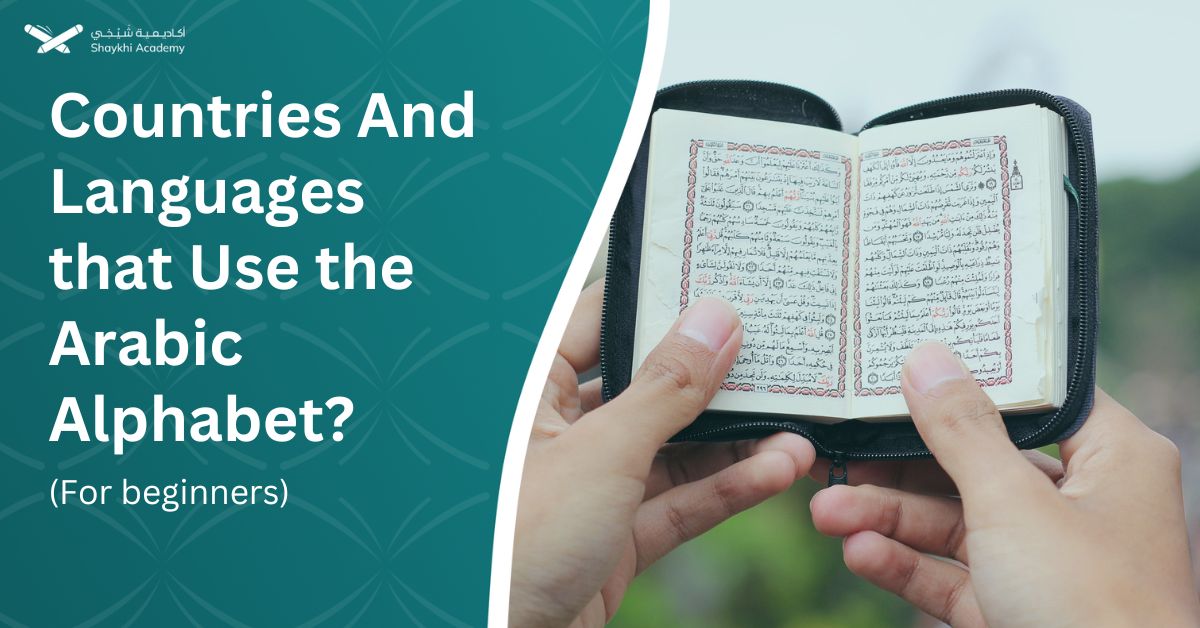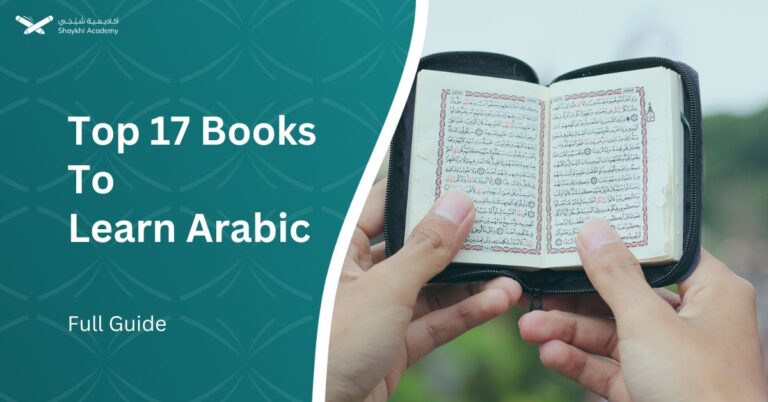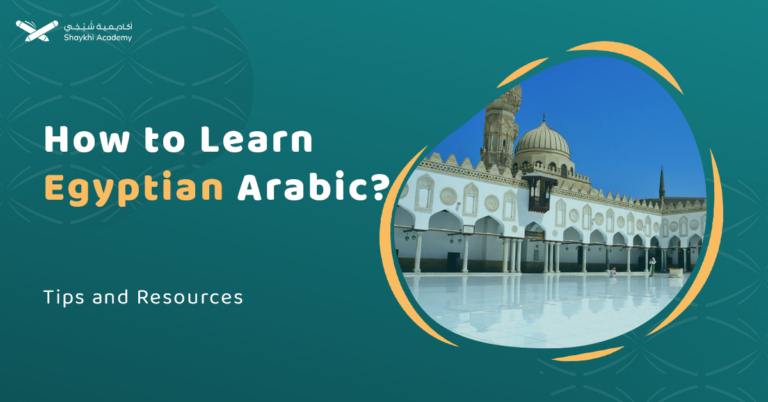The Arabic alphabet stands as a linguistic tapestry that weaves through the rich fabric of diverse languages, contributing to the cultural and historical mosaic of regions extending from the Middle East, to parts of Asia, Europe, and Africa.
This unique feature of the alphabet of the Arabic language makes it one of the most important languages to learn worldwide, and one of the fun and productive activities to indulge kids in; so, Shaykhi Academy has dedicated an Arabic language course for kids.
The Top Languages That Use the Arabic Alphabet:
The Arabic alphabet is used for writing several languages across the Middle East, North Africa, and parts of Asia. Here are some of the prominent languages that use the Arabic alphabet:
1- The Arabic Language:
The Arabic language is primarily spoken in the Arab world, which includes countries in the Middle East and North Africa. The Arabic script is written from right to left and consists of 28 basic letters, with additional diacritic marks to represent vowels and other phonetic elements.
2- The Persian Language:
The Persian language is mainly spoken in Iran, Afghanistan, and Tajikistan. Persian uses a modified version of the Arabic script with additional letters to accommodate sounds not present in Arabic.
3- The Urdu Language:
The Urdu language is predominantly spoken in Pakistan and parts of India. Urdu shares a script with Persian but has some additional letters and diacritic marks. It is written from right to left.
4- The Pashto Language:
The Pashto language is primarily spoken in Afghanistan and Pakistan. Pashto uses a modified version of the Arabic script with additional letters to represent Pashto phonemes.
5- The Kurdish Language:
The Kurdish language is spoken in parts of Iran, Iraq, Syria, and Turkey.
Kurdish can be written in either the Arabic script or the Latin script. The Arabic script version has some additional letters.
6- The Balochi Language:
The Balochi language is predominantly spoken in Balochistan, which spans parts of Iran, Pakistan, and Afghanistan. Balochi uses the Arabic script with some additional letters to represent specific sounds in the language.
7- The Sindhi Language:
The Sindhi language is mainly spoken in the Sindh region of Pakistan.
Sindhi is written in a modified Arabic script with additional letters to represent Sindhi phonology.
8- The Malay Language (Bahasa Melayu):
While Malay primarily uses the Latin script, the Arabic script is used in some regions, especially in religious contexts. When written in the Arabic script, Malay includes additional letters to accommodate sounds not present in Arabic.
9- The Jawi Script:
The Jawi script is used historically in Southeast Asia, particularly in parts of Malaysia and Indonesia. Jawi is an adapted Arabic script used to write Malay and other languages in the region. It includes additional letters to represent non-Arabic sounds.
10- The Azeri Language (Azərbaycanca):
The Azeri language is spoken in Azerbaijan and parts of Iran. Azeri is written in a modified version of the Arabic script, with additional letters to represent Azeri phonetics.
11- The Uighur Script:
The Uighur script is primarily spoken in Xinjiang, China, and Central Asia.
Uighur traditionally used the Arabic script, but it has been replaced by the Uighur script based on the Latin alphabet. However, the Arabic script is still used by some communities.
12- The Bengali Arabic Script:
While the majority of Bengali speakers use the Bengali script, a variant called “Bengali Arabic script” has been historically used in some regions and manuscripts among Bengali Muslims.
13- The Tatar Script:
The Tatar script is spoken in Tatarstan, Russia, and parts of Kazakhstan and Uzbekistan. Tatar can be written in both the Cyrillic and Arabic scripts. The Arabic script version includes additional letters to represent Tatar phonemes.
14- The Dari Language:
The Dari language is primarily spoken in Afghanistan. Dari uses a modified version of the Arabic script with additional letters to accommodate Persian and other phonetic elements.
15- The Wolof Script:
The Wolof script is spoken in Senegal, Gambia, and Mauritania. Wolof can be written using the Arabic script, although it is more commonly written in the Latin script. The Arabic script version includes additional letters to represent Wolof phonemes.
Read Aslo: Where to learn Arabic: countries, universities, and websites.
How Many Languages Use the Arabic Alphabet?
Above, we have listed 15 languages that use the Arabic alphabet, but actually, many more languages use the Arabic alphabet across different regions, reflecting historical, cultural, and religious connections.
While the exact number can vary, it’s estimated that the Arabic script is used for around 30 languages. These languages span the Middle East, North Africa, parts of Central Asia, and even some communities in Southeast Asia.
The versatility of the Arabic script is due to its adaptability to different phonetic systems and the influence of Arabic culture and Islam in these regions.
Does India Use the Arabic Alphabet?
In India, the Arabic alphabet is not widely used for official languages. The majority of the Indian population follows scripts like Devanagari (used for Hindi and other Indian languages), Bengali (used for Bengali and Assamese), Tamil, Telugu, Kannada, Malayalam, and others depending on the region and language.
However, there are certain communities and regions in India where the Arabic script is used. For example:
1- The Urdu Language:
Urdu, one of the official languages of India, is written in the Perso-Arabic script. It shares linguistic and cultural ties with Arabic and Persian. Urdu is spoken by a significant population in India, especially in states like Uttar Pradesh, Bihar, Telangana, and Jharkhand.
2- The Kashmiri Language:
While the predominant script for Kashmiri is the Perso-Arabic script, the usage of this script is primarily in the region of Jammu and Kashmir.
3- The Malayalam Language:
In the Indian state of Kerala, the Arabic script, known as Arabi Malayalam, has been historically used for writing Malayalam in the Muslim community.
Who Used the Arabic Alphabet?
The Arabic alphabet is used in various countries, primarily across the Middle East, North Africa, Europe, and parts of Asia. The widespread of countries that utilize the Arabic language as an official language, and the Arabic alphabet makes many institutions; such as Shaykhi Academy, launch Fusha Arabic courses.
Here is a list of countries where the Arabic alphabet is commonly employed:
1- Saudi Arabia:
Saudi Arabia, the birthplace of Islam, uses the Arabic alphabet as its official script. The language spoken is Arabic, and the country is home to Islam’s two holiest cities, Mecca and Medina. The Arabic language is the language of the Quran, the Holy Book of Islam, which is why joining Shaykhi Academy’s Quranic Arabic courses is central to the study of the Quran.
2- Iraq:
Iraq, located in the heart of the Middle East, utilizes the Arabic alphabet for its official language, Arabic. The country has a rich cultural history, with ancient civilizations contributing to its diverse heritage.
3- Egypt:
Egypt, situated in North Africa, employs the Arabic script for the official language of Arabic. As one of the most populous countries in the Arab world, Egypt has a profound influence on Arab culture and history.
4- Iran:
While Persian is the official language of Iran, the Arabic script was historically used and is still present in some religious and cultural contexts. However, the predominant script for Persian is now the Persian script.
5- United Arab Emirates (UAE):
The UAE, a federation of seven emirates on the Arabian Peninsula, uses the Arabic alphabet for its official language, Arabic. The country is known for its modern cities, diverse economy, and cultural richness.
6- Morocco:
Morocco, located in North Africa, utilizes the Arabic script for its official languages, Arabic and Berber. The country’s unique blend of Arab, Berber, and French influences contributes to its cultural diversity.
7- Algeria:
Algeria, the largest country in Africa, employs the Arabic alphabet for its official languages, Arabic and Berber. With a rich history of struggle for independence, Algeria showcases a unique North African identity.
8- Jordan:
Jordan, situated in the Levant, uses the Arabic script for its official language, Arabic. The country is known for its historical sites, including the ancient city of Petra and the Dead Sea.
9- Yemen:
Yemen, located on the southern tip of the Arabian Peninsula, utilizes the Arabic alphabet for its official language, Arabic. The country has a rich cultural heritage, and its landscape includes historical cities and mountains.
10- Lebanon:
Lebanon, on the eastern Mediterranean coast, employs the Arabic alphabet for its official language, Arabic. Known for its cultural diversity and historic sites, Lebanon has played a significant role in the region’s history.
11- Syria:
Syria, situated in the Levant, employs the Arabic alphabet for its official language, Arabic. The country has a rich historical and cultural heritage, with landmarks such as the ancient city of Damascus.
12- Oman:
Oman, located on the southeastern coast of the Arabian Peninsula, uses the Arabic alphabet for its official language, Arabic. Known for its diverse landscapes, including mountains and deserts, Oman has a long history of maritime trade.
13- Kuwait:
Kuwait, a small but economically significant country in the Persian Gulf, utilizes the Arabic alphabet for its official language, Arabic. The country is known for its oil reserves and modern urban development.
14- Qatar:
Qatar, a peninsula in the Persian Gulf, employs the Arabic alphabet for its official language, Arabic. A rapidly developing nation, Qatar is known for hosting major international events and its economic prosperity.
15- Bahrain:
Bahrain, an island nation in the Persian Gulf, uses the Arabic alphabet for its official language, Arabic. Known for its financial sector and cultural sites, Bahrain has a history rooted in trade and commerce.
16- Libya:
Libya, located in North Africa, utilizes the Arabic alphabet for its official language, Arabic. The country has a diverse landscape that includes the Sahara Desert and a rich archaeological heritage.
17- Tunisia:
Tunisia, on the northern coast of Africa, employs the Arabic alphabet for its official language, Arabic. Known for its ancient ruins and historic cities, Tunisia has a unique blend of Arab and Mediterranean influences.
18- Comoros:
Comoros, an archipelago in the Indian Ocean, uses the Arabic alphabet for the Comorian language. The country has a diverse culture influenced by African, Arab, and French elements.
19- Djibouti:
Djibouti, located in the Horn of Africa, employs the Arabic script for languages such as Afar and Somali. The country is strategically positioned at the entrance to the Red Sea.
20- Mauritania:
Mauritania, situated in West Africa, utilizes the Arabic alphabet for its official language, Arabic. The country has a diverse ethnic makeup and a landscape that transitions from the Sahara Desert to the Atlantic coastline.
21- Sudan:
Sudan, the largest country in Africa, employs the Arabic alphabet for its official languages, Arabic and English. The country has a diverse cultural heritage with influences from Arab, African, and Islamic traditions.
22- Mali:
Mali, located in West Africa, uses the Arabic alphabet for languages such as Arabic and Tifinagh. The country has a rich history, known for the ancient city of Timbuktu and its cultural contributions.
23- Senegal:
Senegal, in West Africa, employs the Arabic alphabet for the Wolof language, especially in Islamic religious contexts. The country is known for its diverse ethnic groups and vibrant music and dance traditions.
24- Niger:
Niger, situated in West Africa, uses the Arabic alphabet for languages such as Arabic and Tamasheq. The country is known for its diverse landscapes, including the Sahara Desert.
25- Chad:
Chad, located in north-central Africa, utilizes the Arabic alphabet for languages such as Arabic and Gorane. The country has a diverse cultural landscape with influences from Arab, African, and Saharan traditions.
26- Indonesia:
While the predominant script for Bahasa Indonesia is Latin, the Arabic script, known as Jawi, has been historically used in some regions and contexts, especially in religious writings and inscriptions.
27- Pakistan:
Pakistan, located in South Asia, uses the Arabic script for its official language, Urdu. The country has a diverse linguistic landscape, with Urdu having significant cultural and historical importance.
28- Afghanistan:
Afghanistan, in South Asia, employs the Arabic script for languages like Pashto and Dari. The country has a rich cultural heritage and has been historically significant in the region.
29- Maldives:
The Maldives, an island nation in South Asia, uses the Arabic script for the Maldivian language, Dhivehi, especially in historical and religious contexts. The country is known for its stunning coral reefs and tropical landscapes.
30- Bosnia and Herzegovina:
Bosnia and Herzegovina, in the Balkans, has communities that use the Arabic script for the Bosnian language, especially in religious and cultural contexts. The country has a diverse ethnic and religious makeup.
31- Albania:
While the official script for the Albanian language is Latin, in some religious and historical contexts, the Arabic script has been used, particularly among Albanian Muslims.
32- North Macedonia:
North Macedonia, in the Balkans, has communities that historically used the Arabic script for the Albanian language, especially in religious and cultural contexts.
33- Montenegro:
Montenegro, also in the Balkans, has communities that historically used the Arabic script, particularly in religious and cultural contexts, reflecting the diversity of the country.
34- Serbia:
Serbia, in the Balkans, has communities that historically used the Arabic script, especially in religious and cultural contexts. The country has a rich cultural heritage and diverse ethnic groups.
35- Kosovo:
Kosovo, in the Balkans, has communities that have historically used the Arabic script for the Albanian language, especially in religious and cultural contexts. The country has a complex history and diverse ethnic and religious communities, contributing to its cultural richness.
What Languages Are Written in Perso Arabic Script?
The Perso-Arabic script is primarily used for writing languages in the Persianate cultural sphere, particularly those influenced by Persian or Arabic linguistic and cultural traditions.
The Arabic alphabet isn’t critical to the construction of Arabic script variants, but also some of the Persian scripts, which makes studying the Arabic alphabetical system very beneficial to anyone interested in studying languages. One can find such materials in MSA courses at academies; such as Shaykhi Academy.
Here are some languages that use the Perso-Arabic script:
1- The Persian Language:
Persian, also known as Farsi, is an Iranian language spoken primarily in Iran, Afghanistan, and Tajikistan. It uses the Perso-Arabic script.
2- The Urdu Language:
Urdu is an Indo-Aryan language spoken in Pakistan and parts of India. It is written in the Perso-Arabic script and has significant linguistic influences from Persian and Arabic.
3- The Pashto Language:
Pashto is spoken primarily in Afghanistan and Pakistan. It uses a modified version of the Perso-Arabic script with additional letters to represent Pashto phonemes.
4- The Kurdish Language:
Kurdish, spoken in regions spanning Iran, Iraq, Syria, and Turkey, can be written using the Perso-Arabic script. However, there are also efforts to use the Latin script for Kurdish in some regions.
5- The Balochi Language:
Balochi is spoken in Balochistan, which spans parts of Iran, Pakistan, and Afghanistan. It uses a version of the Perso-Arabic script.
6- The Sindhi Language:
Sindhi is spoken in the Sindh region of Pakistan and uses a modified version of the Perso-Arabic script.
7- The Saraiki Language:
Saraiki is spoken in parts of Pakistan and uses the Perso-Arabic script. It is closely related to Punjabi.
8- The Kashmiri Language:
While the predominant script for Kashmiri is Sharada, the Perso-Arabic script has been historically used, especially in religious and cultural contexts.
9- The Dari Language:
Dari, one of the official languages of Afghanistan, uses a modified version of the Perso-Arabic script. It is similar to Persian but has distinct linguistic features.
10- The Azerbaijani Language (Azərbaycanca):
Azerbaijani, spoken in Azerbaijan and parts of Iran, historically used the Perso-Arabic script, but it has transitioned to the Latin script. However, in historical texts, the Perso-Arabic script can still be found.
Unlock the Beauty of the Arabic Language! Join Our Course Today!
Embark on a transformative linguistic journey with our Fusha Arabic course at Shaykhi Academy. Whether you’re a beginner or seeking to deepen your Arabic proficiency, this course offers a comprehensive exploration of the classical Arabic language, Fusha.
Dive into the elegance of the Arabic script, unravel the intricacies of grammar, and develop conversational skills that will open doors to a rich cultural heritage.
Our courses offer you the guidance of expert professional Native Arab tutors, who will empower you with deep cultural insights through our comprehensive curriculum.
Enroll now and embark on a linguistic adventure at Shaykhi Academy!
The beauty of the Arabic alphabet lies not only in its aesthetic appeal but in its role as a vessel that carries the stories, traditions, and expressions of a multitude of languages, creating a timeless symphony of human communication.

































